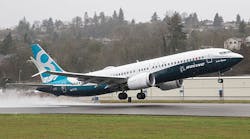Aerospace executives will doubtless toast some orders and drop hints about new aircraft types to keep the anoraks happy at this week’s Farnborough International Airshow. After more than five years of booming sales, there will also be plenty of earnest discussion about whether the industry’s cycle has peaked.
But putting aside such longer-term concerns — and ignoring the usual breathless tallying of Airbus and Boeing orders — the jet-makers have more urgent matters to attend to. These may seem prosaic but they’re pressing nonetheless, with cost control and the resilience of supply chains uppermost. If that sounds a little dull or abstract, it really boils down to a simple question …
Can Airbus and Boeing build the planes for which they’ve already received orders on time, and on budget?
Of course, it’s natural that investors make a fuss about demand. They’re right to be skeptical about claims that the industry is no longer cyclical. Company values still tend to reflect the order book. So far this year, sales have been a bit underwhelming, while airline passenger traffic growth has slowed.
But that’s not a reason to worry yet. Slower demand was inevitable after a stellar run. Order books remain plump: the one at Airbus covers 10 years of production at current rates. Like Boeing, it could easily survive a few cancellations (absent a global recession). Investors shouldn’t panic if Farnborough sales don’t set the world alight.
Instead, they’d be better advised to focus on production. The manufacturers and their suppliers still have to show they can cope with that huge spike in orders over recent years and the technical demands of churning out large volumes of new, fuel-efficient aircraft. That will ultimately dictate whether companies earn a return that justifies their massive upfront investments. Right now, they’re struggling.
Take Airbus, which is grappling with a cornucopia of production challenges. The twin-aisled A350 has been delayed by a shortage of seats and toilets — the company has so far delivered only 12 of a promised 50 aircraft targeted for this year. The single-aisle A320neo program has suffered from teething troubles with a new Pratt & Whitney engine. Meanwhile, the endlessly-delayed A400m military transporter has yet more problems, this time with propeller gearboxes.
Getting this stuff right isn’t as sexy as unveiling a new aircraft to the adoring airshow masses, but it has a direct impact on the bottom line. David Perry at JPMorgan expects Airbus to book a 1.75 billion euro ($1.94 billion) charge related to the A400m and A350 this year. That’s almost two-thirds of last year’s net income. Airbus targets a stable profit before special items in 2016. On current form, that’s quite ambitious (to put it mildly).
Boeing’s challenges are equally pressing. With the Airbus sales team loving the weak euro, their great U.S. rival is under pressure to cut costs and conserve cash. Boeing has spent more than $30 billion on the 787 Dreamliner but is yet to prove it can recoup that. Unless it cuts 787 production costs much further, or raises prices, it may be forced to book a charge — possibly a big one.
Shares in Boeing and Airbus have fallen this year and both trade on about 15 times estimated earnings. Delivering on production would shore up confidence in those earnings and prove it was worth booking all those orders in the first place.
By Chris Bryant



